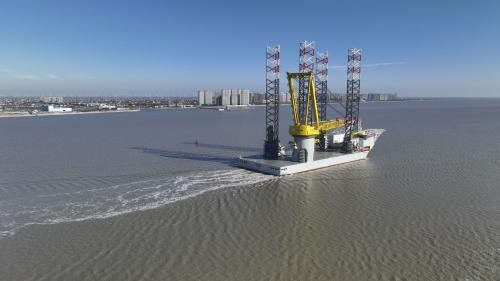With the increasing demand for decarbonisation and lower-cost green electricity, offshore wind turbine and foundation components continue to increase in size, to a point where their dimensions have largely outgrown the current market installation capability. The global offshore wind industry is already forecasting installation vessel shortages by the mid-decade.
“The bigger the turbine, the more power you generate,” explains Rutger Standaert, manager of vessel construction at Belgium-based offshore engineering company Jan De Nul Group. “This simple rule has been shaping the offshore wind industry since its early days. Consequently, technological limits are constantly being pushed.”
To illustrate the point, Standaert notes that today’s blades are up to 107m long and will soon reach the 120m mark. “But that’s all tech for tech’s sake if you can’t get those turbines out to sea and installed properly,” he adds.
Jan De Nul has been preparing for the arrival of these next-generation offshore wind components and in 2019 announced the order of Voltaire, “the world’s tallest jack-up installation vessel”. The vessel was delivered by COSCO Shipping Shipyard in Nantong, China, at the end of 2022 and is now on its way to Europe to begin wind farm installations.
Designed in-house, and pushing engineering boundaries, Voltaire is built to transport, lift and install offshore wind turbines, transition pieces and foundations. The vessel has nearly double the deck space of Jan De Nul’s previous largest vessel and, with its crane upright and legs at maximum depth, stands taller than Paris’s Eiffel Tower. It can handle wind turbines over 270m high and blades 120m long.
Key features include a main crane of over 3,000tonnes, an operating depth of around 80m, a capacity to lift 16,000tonnes of useful cargo out of the water (the equivalent to more than 40 Boeing 747s) and accommodation for 100 persons. The vessel has four 130m legs to raise itself above the sea level for stable working conditions and is equipped with a DP2 diesel-electric propulsion system consisting of eight gensets, four stern thrusters, two bow thrusters and two retractable bow thrusters.
“We have a lot of experience with dredging vessels, but we had never built a jack-up installation vessel ourselves,” says Jan Van de Velde, head of fleet construction at Jan De Nul. “The challenge was to integrate the legs into the vessel, taking into account all operational aspects. Fortunately, we have learned a lot from the two jack-ups (the Vole au vent and the Taillevent) we’ve already been working with.”
Thanks to those legs, the Voltaire can install wind turbines further out at sea than any other vessel, unlocking a whole new area for energy purposes. “Off the Scottish coast, for example, expensive floating wind farms are often the only way to tap into offshore wind. The water is too deep for fixed wind farms, but the Voltaire can offer new opportunities,” notes Standaert.
Voltaire is not only innovative in terms of its capacity but also when it comes to sustainability. The vessel can operate on second-generation biodiesel that will reduce the fuel carbon footprint by up to 90%. It is also equipped with an advanced dual exhaust filter system, removing up to 99% of nanoparticles from emissions using a diesel particulate filter and reducing the NOx emissions and other pollutants by means of a selective catalytic reduction system to levels in accordance with EU Stage V regulation.
“The Voltaire is the first certified ultra-low emission vessel (ULEv) of her kind,” says Standaert.
For its inaugural assignment, Voltaire will mobilise to the United Kingdom for the construction of the 3.6GW Dogger Bank offshore wind farm in the North Sea, transporting and installing 277 huge GE Haliade-X turbines, each capable of generating up to 14MW. As such, the Voltaire will contribute to the largest offshore wind farm in the world, generating enough energy to power up to six million homes every year – around 5% of the UK’s electricity needs.
Not only is the vessel ready for the future of offshore renewables, but it is also deployable for the oil and gas industry, and for the decommissioning of offshore structures.




